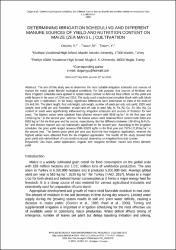| dc.contributor.author | Doğan, Y. | |
| dc.contributor.author | Toğay, Necat | |
| dc.contributor.author | Toğay, Yeşim | |
| dc.date.accessioned | 2020-11-20T14:43:40Z | |
| dc.date.available | 2020-11-20T14:43:40Z | |
| dc.date.issued | 2019 | |
| dc.identifier.issn | 1589-1623 | |
| dc.identifier.issn | 1785-0037 | |
| dc.identifier.uri | https://doi.org/10.15666/aeer/1702_15591570 | |
| dc.identifier.uri | https://hdl.handle.net/20.500.12809/1215 | |
| dc.description | WOS: 000462830400007 | en_US |
| dc.description.abstract | The aim of this study was to determine the most suitable irrigation schedules and sources of manure for maize under Mardin ecological conditions. For this purpose, four sources of fertilizer and three irrigation schedules were applied in hybrid maize cultivar to find out their effects on the yield and yield factors in the years of 2014 and 2015. The study used a randomized complete block with split block design with 3 replications. In the study, significant differences were determined on traits at the level of 1% and 5%. The plant height, first cob height, cob length, number of seeds per cob, cob yield, 1000 seed weight, seed yield per unit, hectoliter, protein and oil ratio in seed, Mg, K, Fe, Ni, Cu, Zn, Mn, Na, Ca content of seeds were significantly influenced by irrigation schedules and sources of fertilizer for two years. The highest values were obtained from chicken manure with 9646 kg ha(-1) in the first year and 11019 kg ha(-1 )in the second year, whereas the lowest values were obtained from control with 6363 and 6662 kg ha(-1) for the first year and the second, respectively. But the difference between 180-80 kg N-P(2)0(5) ha(-1) and chicken manure was not statistically significant in the second year. According to the irrigation schedules, the grain yield ranged between 6386-10678 kg/ha in the first year and 7575-12133 kg ha(-1) in the second year. The lowest grain yield per area was from the four-irrigation application, whereas the highest values were obtained from the six-irrigation application. The results of the study showed that grain yield and nutrient level of corn seeds increased, depending on irrigation time and number. | en_US |
| dc.description.sponsorship | M.A. University Research Fund [MAU-BAP-2015-MYO-15] | en_US |
| dc.description.sponsorship | This study is a research artcile and supported as a project number MAU-BAP-2015-MYO-15 by M.A. University Research Fund. | en_US |
| dc.item-language.iso | eng | en_US |
| dc.publisher | Corvinus Univ Budapest | en_US |
| dc.item-rights | info:eu-repo/semantics/openAccess | en_US |
| dc.subject | Zea Mays | en_US |
| dc.subject | Water Application | en_US |
| dc.subject | Organic and Inorganic Fertilizer | en_US |
| dc.subject | Macro and Micro Element | en_US |
| dc.subject | Yield | en_US |
| dc.title | DETERMINING IRRIGATION SCHEDULING AND DIFFERENT MANURE SOURCES OF YIELD AND NUTRITION CONTENT ON MAIZE (ZEA MAYS L.) CULTIVATION | en_US |
| dc.item-type | article | en_US |
| dc.contributor.department | MÜ, Fethiye Ali Sıtkı Mefharet Koçman Meslek Yüksekokulu, Bitkisel Ve Hayvansal Üretim Bölümü | en_US |
| dc.contributor.institutionauthor | Toğay, Necat | |
| dc.contributor.institutionauthor | Toğay, Yeşim | |
| dc.identifier.doi | 10.15666/aeer/1702_15591570 | |
| dc.identifier.volume | 17 | en_US |
| dc.identifier.issue | 2 | en_US |
| dc.identifier.startpage | 1559 | en_US |
| dc.identifier.endpage | 1570 | en_US |
| dc.relation.journal | Applied Ecology and Environmental Research | en_US |
| dc.relation.publicationcategory | Makale - Uluslararası Hakemli Dergi - Kurum Öğretim Elemanı | en_US |


















